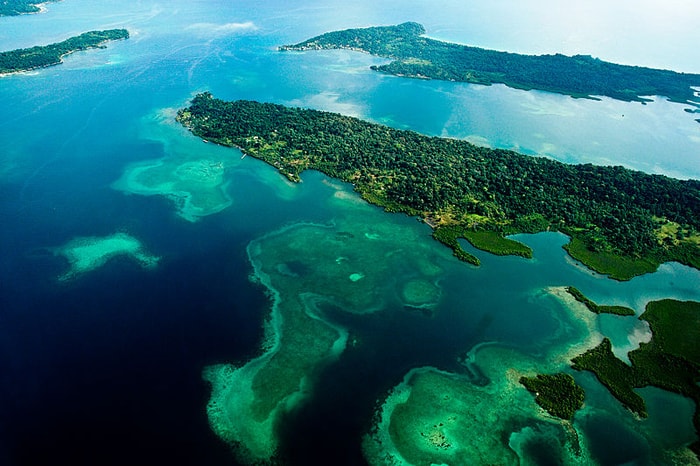Bocas del Toro is no secret to Central American travelers or perpetual tourist-visa renewers from Costa Rica. The island chain off the Caribbean coast of Panama sees thousands of visitors every year, and Isla Colón, the capital and economic hub of the area, receives most of that traffic. However, a five-minute boat ride to the east of Isla Colón’s Bocas town takes travelers to Bastimentos, a quiet island where the days fade into a hammock-induced stupor of relaxation so delicious it leaves guests kicking themselves, wondering why they didn’t visit the island years ago.
Old Bank, the island’s westernmost settlement, is a miniscule town that affords a valuable look into Central American and Caribbean culture, unmarred by the footprints of too many trampling tourists. Those who prefer gourmet dining to natural beauty may find the village too remote, but with coral reefs, wilderness beaches, mangrove forests and solid surf breaks at hand, Old Bank makes a great base camp for the adventurous.
There are no roads in Old Bank, just a series of interconnected footpaths. The village’s main drag is a paved sidewalk that runs from the community basketball court on one end of town to the cemetery on the other, dividing the homes built on the hillside from those constructed on stilts over the water. Village residents, who can be heard speaking Guari-guari, Bocas del Toro’s own Creole language, celebrate the island’s slow pace. Excited to share their laid-back culture, dreadlocked young men welcome newcomers to the island, shaking their hands and preaching their unofficial mantra: “No cars, no stress.”
Known for its consistent waves and powdery golden sand, Wizard Beach is only a brief hike – or an even shorter boat ride – from Old Bank. A muddy trail starting just outside of town leads hikers about 20 minutes through the jungle and across the island to the palm-lined beach. From there it is less than another hour’s hike to reach Red Frog Beach, known for the nearly microscopic red poison dart frogs that live in the nearby undergrowth. Entrance to the beach, because it lies within the boundaries of Bastimentos National Marine Park, costs $3.
Bastimentos is also home to Nívida Cave. Locals refer to it as “the bat cave,” and it is said to be Panama’s deepest. Explorers can hire a launch (prices negotiable) to take them around the island, up a channel overhung by dense mangroves and to the house of Eldo, a joke-loving indigenous Ngöbe-Buglé man who lives in a remote corner of the island with his family. Eldo’s wooden rancho is a short walk from the mouth of the cave, and he knows his way through it better than anyone. Although he’s never reached the end of the cave, he will happily don a headlamp and lead tours into the dark bowels of the island for $5 per person.
Inside, cavers wade through refreshing, chest-deep water while cave shrimp lurch around their feet and nectar bats blast like little winged bullets at their heads, pulling away at the last possible instant. The limestone walls and impressive formations make the perfect hangout for large spiders and crickets. Accustomed to the wet dark, they are the sorts of beasts that might appear clawing at contestants’ mouths on some trashy, sadistic reality TV show.
Once Eldo and the rest of the cavern’s guests reach the dead end of one fork of the labyrinthine cave, they are greeted by a natural swimming hole, complete with a waterfall and a diving platform carved away by the underground river.
Like Eldo, most locals have something special to share with visitors. An elementary school teacher and musician known only as “the Jaguar” shares his hometown pride in the lyrics he writes for his salsa and calypso band, The Jaguars. The band is made up of family members and friends and plays songs with titles like “Bastimentos Is on My Mind” and “Nobody Wants to Leave From Bastimentos.” In the song “Bocas del Toro,” the Jaguar sings, “Bocas del Toro is the most beautiful place in my Panama; I can say without exaggerating that it’s just like heaven.”
The Jaguar is something of a Caribbean renaissance man who runs a seaside hotel called Hospedaje El Jaguar in addition to his other pursuits. He has lived through a time of much change in his beloved part of Panamanian heaven. He witnessed the quiet community transform into a destination people flock to from all over the world, albeit in relatively small numbers. He says that the first tourists came to the island only 16 years ago.
“The tourists would pay to stay with local families who had extra rooms,” the Jaguar remembers. “It wasn’t until later that the first hotels got built.”
These days, Bastimentos has its fair share of rooms for rent, and farther down the western shore of the island is the Red Frog Beach Resort and Marina, a string of freshly erected villas, dorms and marina slips whose administration focuses heavily on real estate and development. Constructed just outside of Bastimentos National Marine Park, this Gringo-colonized expanse sits in stark contrast to the rest of the island’s natural beauty and small community feel.
Consider the difference between the resort and Salt Creek, a Ngöbe-Buglé fishing village on the northeast corner of the island. With its thatched roofs and a population of just over 300, Salt Creek is way off the beaten path and is sure to see changes as more visitors begin to anchor their yachts and sailboats nearby.
Going There
Costa Rica offers bus service several times a day from the Gran Caribe bus terminal in San José to the southeastern border town of Sixaola, from where travelers walk across the bridge over the Río Sixaola into Panama, where taxis await to transport visitors to Almirante and the marine taxis that go to Bocas. Additionally, direct shuttles to Bocas del Toro can be booked at numerous locations between Limón and Manzanillo on Costa Rica’s southern Caribbean coast.






